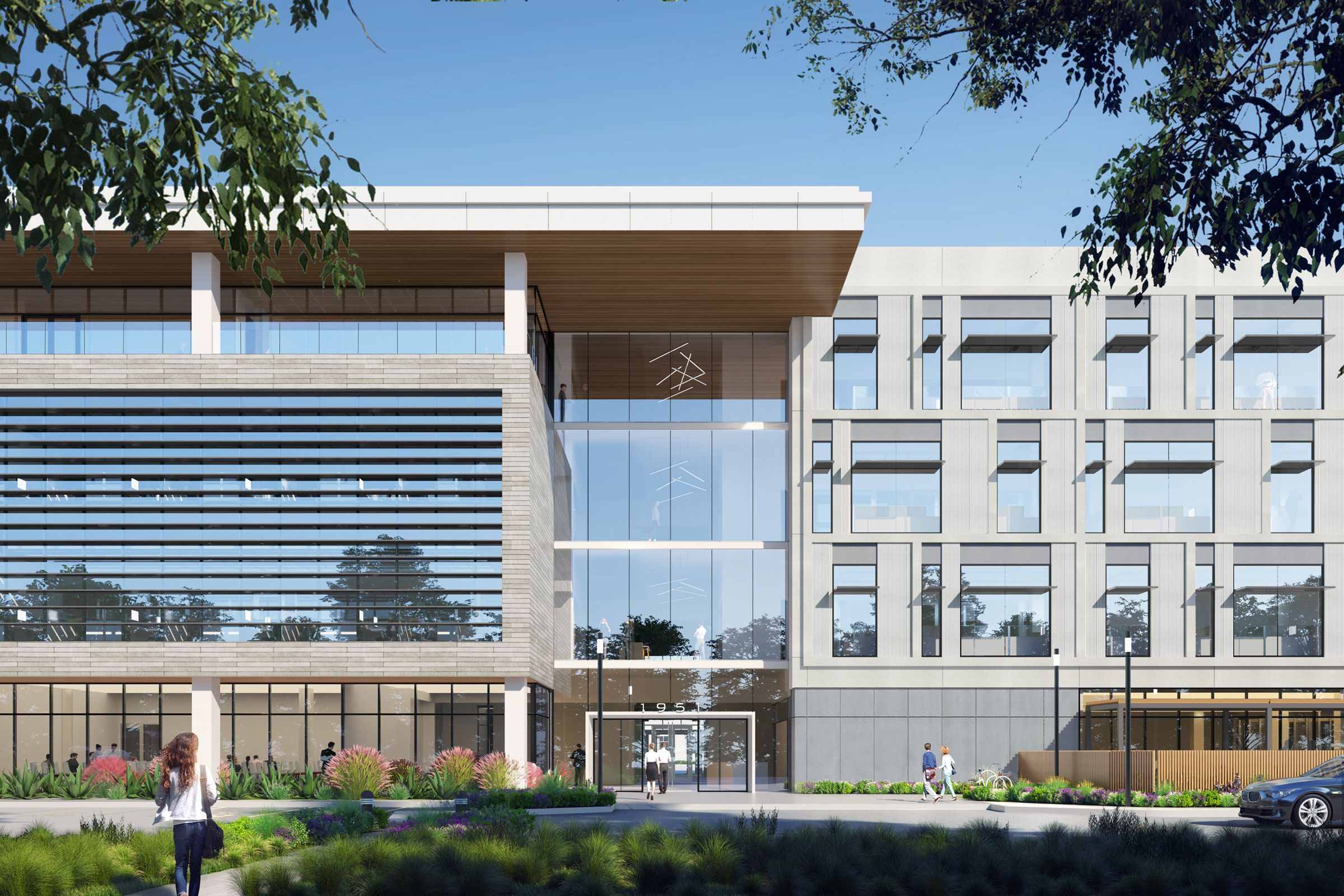Story at a glance:
- By the end of 2019 11 states and 160 cities had official goals to get 100% of their electricity from clean sources by 2050.
- Current typical HVAC systems can be replaced with alternative systems that use heat pumps for heating instead of gas.
- An Exelixis building in California shows the decarbonization potential.
What is building decarbonization?
Buildings in the US account for 40% of carbon emissions. And 80% of that is from electricity use; the remainder is from the combustion of fossil fuels for heating and other uses at the building.
As many states, utilities, and large corporations are moving to get electricity from clean, carbon neutral sources, it’s clear that electricity is becoming the carbon-free choice of energy for many in the US.
Buildings that use natural gas and other fossil fuels for heating will be stuck producing carbon emissions, as electricity becomes increasingly carbon-free. Natural gas can now be replaced with electric systems that provide equivalent or better service. An all-electric building coupled with a renewable or carbon-free source of electricity is considered to be a decarbonized building.
The Emergence of Clean Electricity Grids
A complete transformation of the electric grid is underway.
Over the last 100 years this grid has been dominated by the burning of fossil fuels. During this period fossil fuels have been cheap and abundant. This facilitated a vast expansion of what many engineers consider to be the largest machine humans have created.
In recent years solar and wind power have begun to overtake fossil fuels in cost and new deployments. In 2020 they were at historic low costs and accounted for more than three quarters of all new power added to the grid. In parallel over the last few years in the US, more than 200 high carbon output coal plants have been retired.
Perhaps the most significant change in the electric grid comes from the state and municipal policies that provide a roadmap for transition to zero or close to zero carbon electricity. By the end of 2019 11 states and 160 cities had official goals to get 100% of their electricity from clean sources by 2050 or sooner.
Several utilities have made a similar commitment, including Duke Energy, one of the largest investor-owned utilities in the US.
California is already 55% carbon-free on its electric grid and has a roadmap to get to 100% by 2045. In seven states community choice aggregation (CCAs) often provide electric customers an option to purchase fully renewable power today. Much of the Northwest of the US is already well above 90% carbon-free due to the reliance on large hydroelectric power.
Many of the US’s largest corporations—including Apple, Microsoft, Kohls, and Bank of America—have made commitments to get their electricity from carbon-free sources, namely solar and wind energy. They are doing this by wholesale purchases of renewable energy or investing solar or wind power plants.
All-Electric Building Equipment
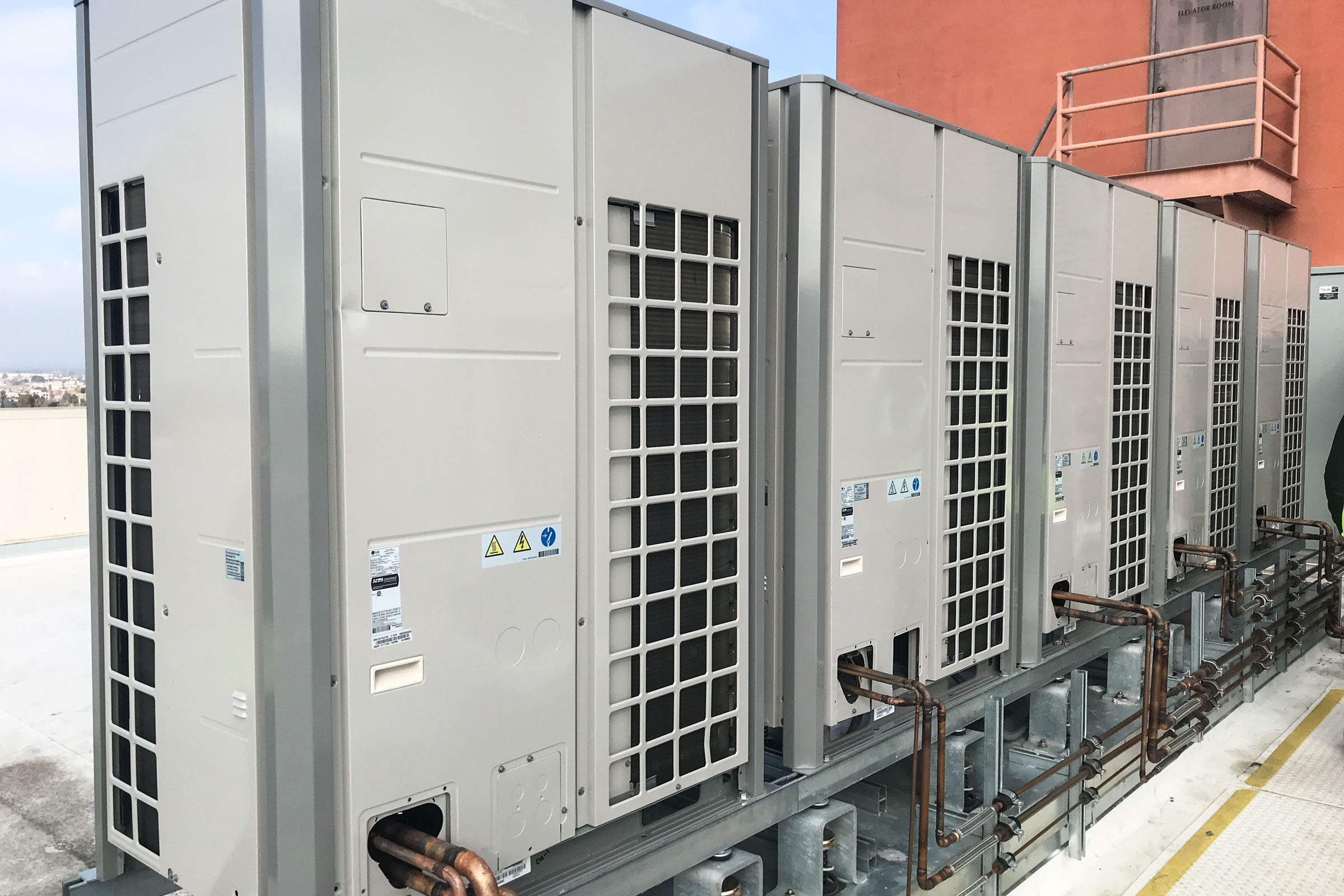
Variable Refrigerant Flow heat pump system. Courtesy of PEI
Heat pumps use the refrigeration cycle to transfer heat energy from one space to another. Similar to a refrigerator, home AC unit, and car AC unit, a heat pump uses a compressor and refrigerant to absorb heat from a cold space and release it to a warmer one.
Current typical HVAC systems can be replaced with alternative systems that use heat pumps for heating instead of gas. The new generation of heat pump systems for space heating use variable speed drives for the fans and compressors so that the output of the system matches the need of the building. These systems provide better comfort in a way that is more efficient.
There is also an opportunity to replace more conventional domestic hot water (DHW) heaters with heat pumps. In fact, the residential heat pump water heater (HPWH) market is already far more developed than the heat pump market for space heating.
The latest generation of heat pump technology has now advanced to the point where they are able to operate at all but the lowest ambient temperatures. This includes the use of CO2 as a refrigerant, which further reduces the greenhouse gas emissions of a building.
Electrical Resistance
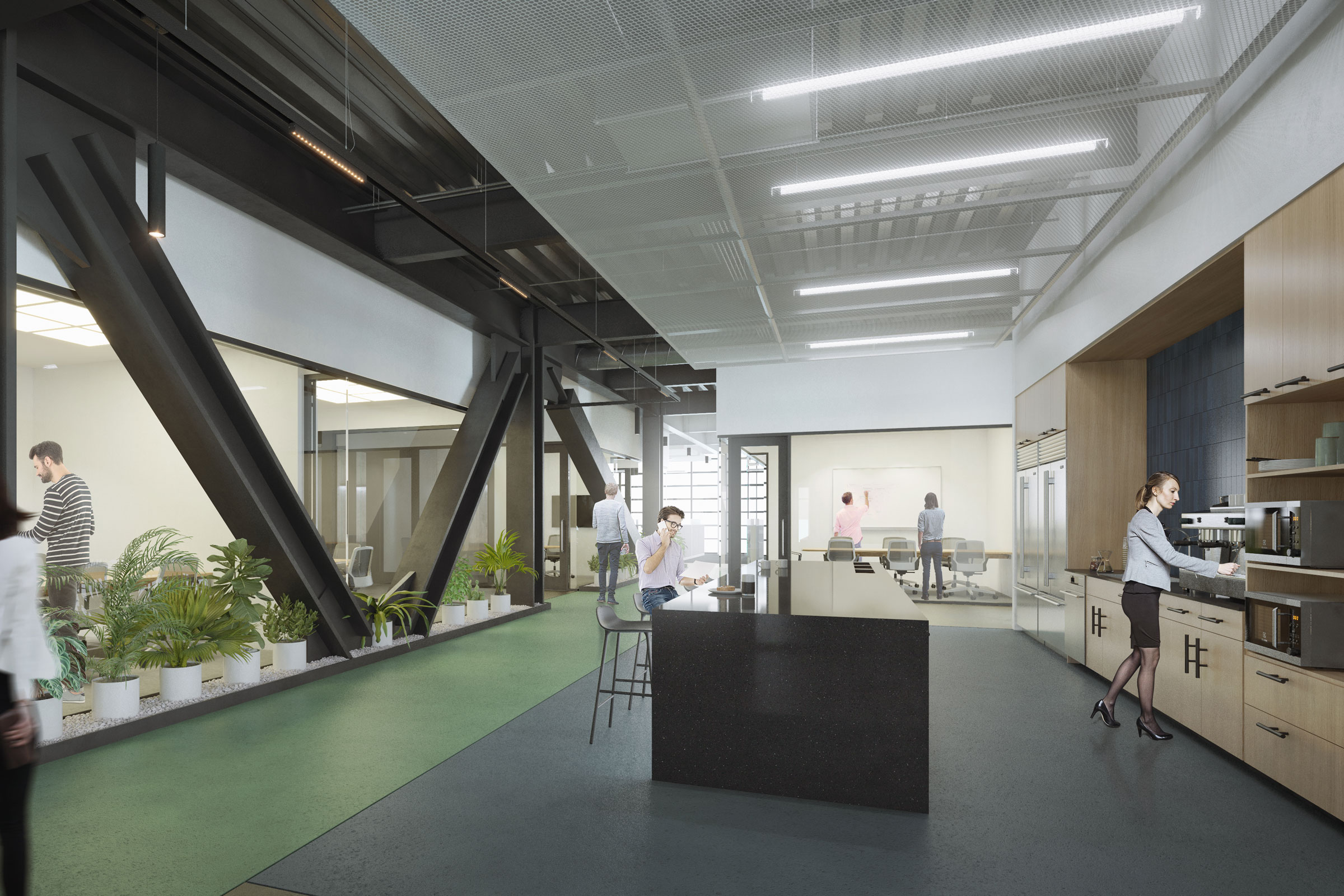
Rendering courtesy of Brick Architects
Some may also consider switching from a gas boiler to electric resistance heating as an electrification measure, particularly given the lower upfront cost. However, electric resistance is a problematic solution, as it increases energy use by approximately 300% and encourages electricity use in the winter when renewable solar energy production is at its lowest. In some instances, when a building is super insulated and required very little heating electric resistance heating can make sense.
Induction Cooking
Gas cooking can be replaced by either electric resistance or induction cooking equipment. Electric resistance, which uses an integrated electrical heating device to replace the gas burner, is already widely used in residential settings.
A newer form of electric cooking, which is applicable in residential and commercial settings, is electric induction cooking.
Unlike electric resistance and gas, which relies on indirect radiation to heat, electric induction cooking uses direct induction heating. Electric currents directly heat pots and pans instead of the cooktop or surrounding air. This makes induction cooking safer, faster, more efficient, and more precise than gas. Induction cooking also eliminates combustion of natural gas, which creates unhealthy emissions in kitchens.
Energy and Carbon Impacts
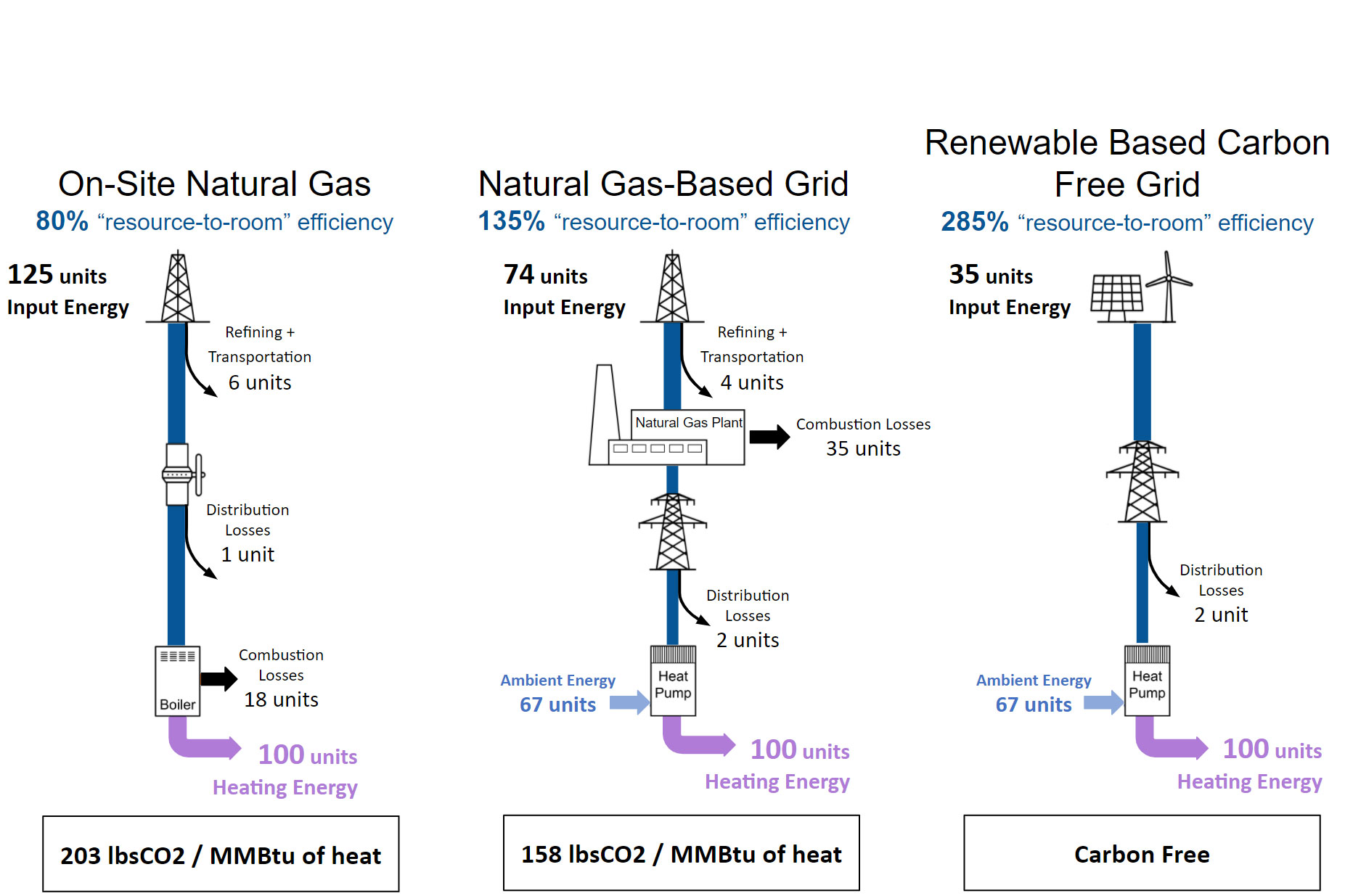
“Resource to Room” Efficiency can improve by more than four times when using heat pumps connected to a renewable energy source. Courtesy of PEI
With the use of electric heat pump systems, buildings can operate more efficiently and with lower carbon even when powered by natural gas power plants.
Since heat pumps operate on the principle of moving heat from cold spaces (outside) to warm spaces (inside), they use about one unit of electricity to move three units of heat.
For this reason, even heat pumps connected to a natural gas grid use less energy than burning natural gas directly. When coupled with renewable energy the overall system efficiency or “resource to room” efficiency goes from 80% to 285% or better.
We recently performed an energy study of building electrification in several cities in the US. This study looked at a typical 50,000 square foot office building that used either the common variable air volume (VAV) reheat gas boiler system or a form of all-electric heat pump called a variable refrigerant flow (VRF) system.
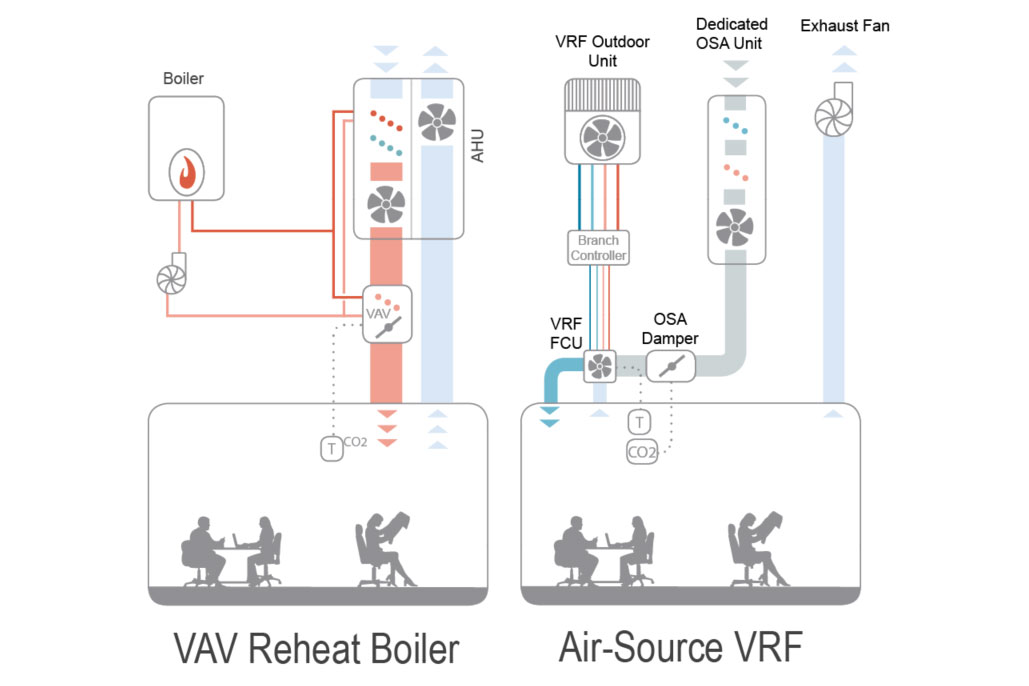
VAV reheat with boiler and air-source VRF system schematics. Drawing courtesy of PEI
Electric heat pumps have lower energy costs and lower carbon emissions than gas boiler hot water heating systems in all cities modeled. Natural gas is less expensive per unit of energy than electricity which is why it has been widely used for space heating and water heating up until now. However, the high efficiency of electric heat pumps over gas boilers provides energy savings despite the cost imbalance.
The ultimate goal of building decarbonization is to connect all-electric buildings to carbon-free sources of electricity.
Nonetheless, all-electric buildings connected to many of the current US electrical grids will provide significant carbon reduction savings today.
As grids lower their carbon emissions or as buildings add solar PV systems, the emissions will only improve over time.
Capex Costs
Costs are always a factor in building systems decisions. Most builders find that the costs of well-designed electric buildings are equivalent to their natural gas alternatives.
Heat pump systems where the compressor is set up to provide heating and cooling are typically cost competitive today.
In the residential sector, central or split type heat pump systems have been used for many years and are cheaper to install than a separate furnace and air conditioner.
In the commercial sector VRF systems that provide heating and cooling from a single compressor system are also competitive with gas systems today. VRF systems are already widely used by developers for both multifamily and office building projects.
As the market grows for heat pump systems, we expect costs to decrease in the coming years.
Embodied Carbon
Once the energy use of a building has been decarbonized, or what some people refer to as the operational carbon, we can and should look at the embodied carbon in the building materials and techniques used in the construction.
Currently energy does dominate the carbon emissions of a building. But for developers who want to go the extra mile, design teams are asked to analyze and select lower carbon materials.
There is a rapid growth in the use of more wood, especially in commercial buildings.
Mass timber structural systems capture or sequester carbon in the building material for the life of the building. Lower carbon concrete is being developed by several startups and purchasing materials that are manufactured close to the building site helps to lower the carbon footprint of transporting building materials to the construction site.
Case Study
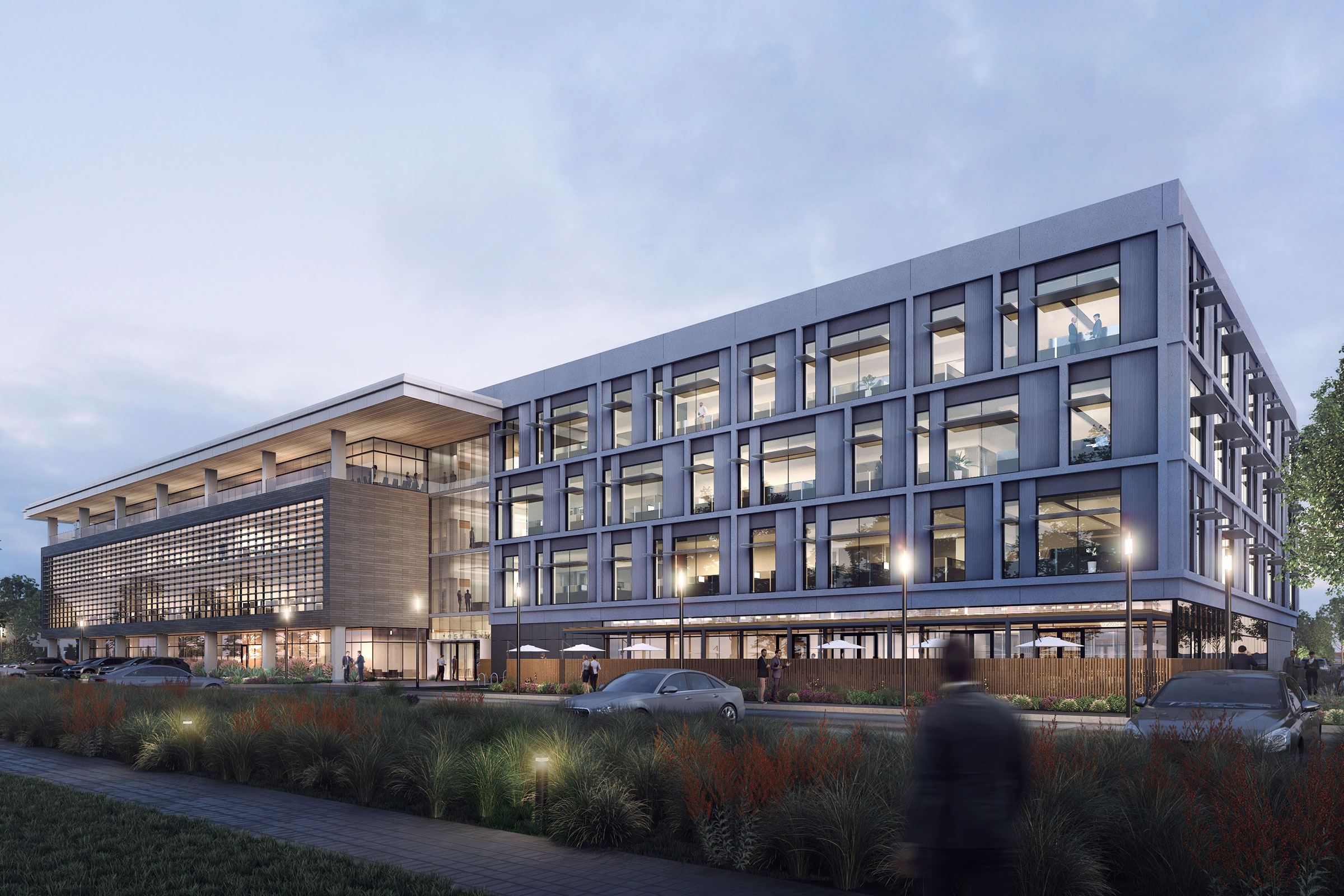
Decarbonized office building in Alameda, California. Rendering courtesy of Brick Architects
In a recent 220,000-square-foot office in Alameda, Califiornia, all of the heating and cooking is electric. The building, designed for cancer research company Exelixis, does not use gas for any purpose.
This all-electric building uses VRF systems to provide heating and cooling to all space. The kitchen, which is the largest domestic hot water usage in the building, is provided by an energy-efficient heat pump system.
The building is targeting LEED Gold with 35% energy savings over ASHRAE 90.1. And 50% of the building energy will be covered by solar PV on the roof.
The construction cost for the building is in line with other developer built buildings in the neighborhood. The building, developed by srmErnst, will be part of the growing Exelixis campus in Alameda.
As of January 1, 2020, Alameda Municipal Power (AMP), the local utility provider, provides 100% clean energy to all customers. The carbon-free source electricity (onsite and offsite) in addition to the all-electric building design makes the operation of the building fully decarbonized.
Over the 50-year lifetime of the building, we expect to save almost 120 million pounds of carbon dioxide compared to the same building using a gas for heating, domestic hot water and cooking. and on an electrical grid with US average carbon intensity levels.
Conclusions
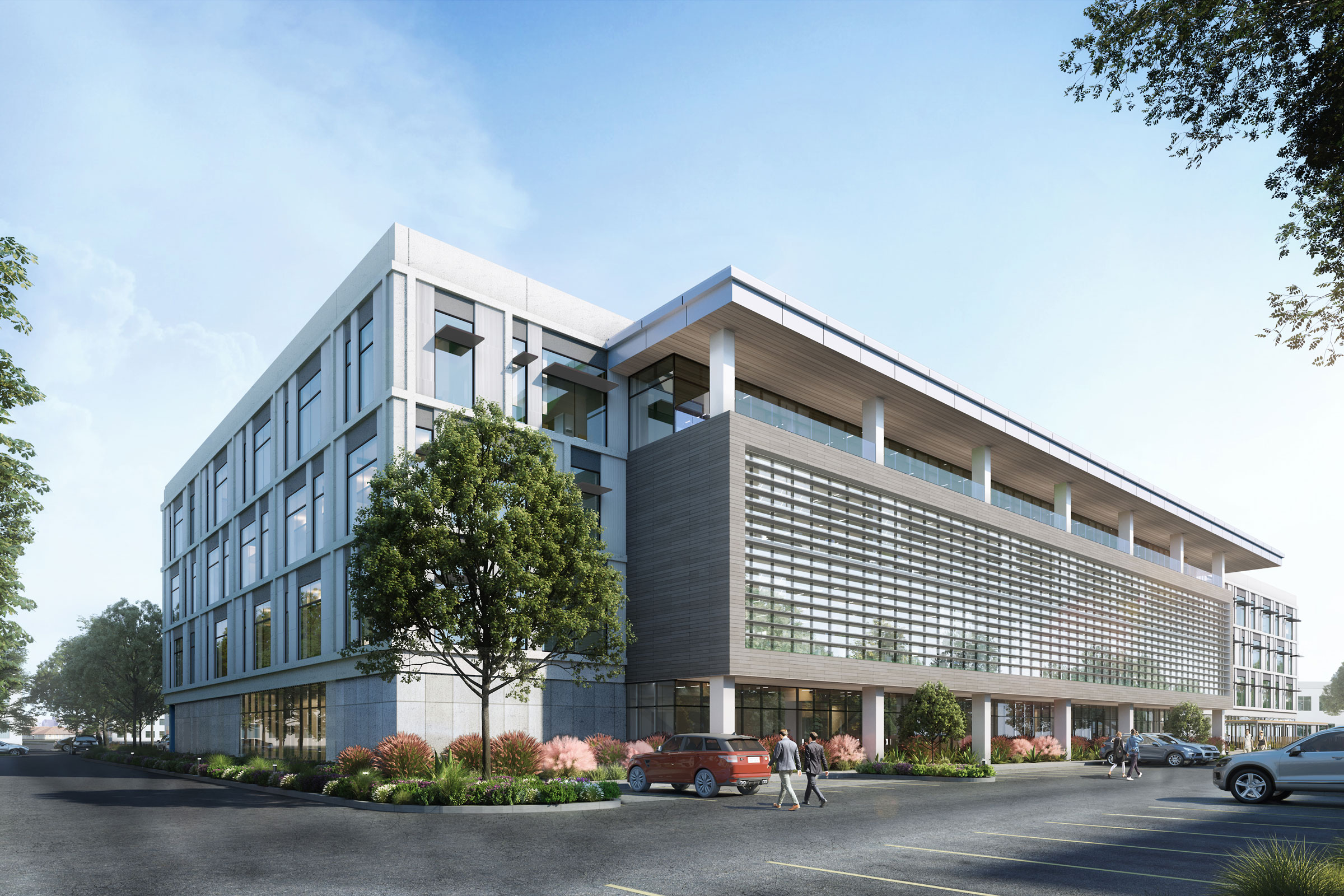
Rendering courtesy of Brick Architects
All-electric buildings have been around for a long time. The difference today is efficient heat pump systems and induction cooking provide as good as or better service and comfort than their gas counterparts.
When electric buildings are supplied with carbon-free or renewable based electricity the operation of the building is decarbonized. In many areas, or by purchasing renewable based electricity, full decarbonization is possible today. Even where full decarbonization is not possible due to grid constraints all-electric buildings can result in substantial carbon reductions and will only improve over time as more renewables are added to the grid.
Designers and developers play a special role in lowering the carbon emissions of buildings. The decisions and recommendations that we make as professionals dwarf our personal carbon footprint. Decarbonized buildings give us a unique opportunity to steer the trajectory of climate change in our communities.
Avril Levasseur and Jorlyn Le Garrec also contributed to this article.

